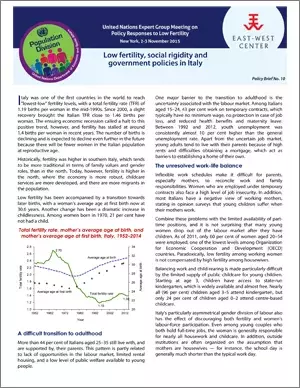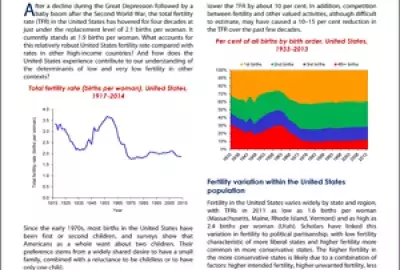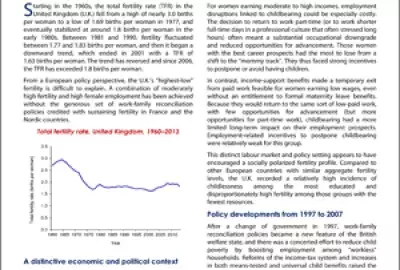Error message

Italy was one of the first countries in the world to reach "lowest-low" fertility levels, with a total fertility rate (TFR) of 1.19 births per woman in the mid-1990s. Since 2000, a slight recovery brought the Italian TFR close to 1.46 births per woman. The ensuing economic recession called a halt to this positive trend, however, and fertility has stalled at around 1.4 births per woman in recent years. The number of births is declining and is expected to decline even further in the future because there will be fewer women in the Italian population at reproductive age. Historically, fertility was higher in southern Italy, which tends to be more traditional in terms of family values and gender roles, than in the north. Today, however, fertility is higher in the north, where the economy is more robust, childcare services are more developed, and there are more migrants in the population. Low fertility has been accompanied by a transition towards later births, with a woman's average age at first birth now at 30.6 years. Another change has been a dramatic increase in childlessness. Among women born in 1970, 21 per cent have not had a child.
|
Italy was one of the first countries in the world to reach "lowest-low" fertility levels, with a total fertility rate (TFR) of 1.19 births per woman in the mid-1990s. Since 2000, a slight recovery brought the Italian TFR close to 1.46 births per woman. The ensuing economic recession called a halt to this positive trend, however, and fertility has stalled at around 1.4 births per woman in recent years. The number of births is declining and is expected to decline even further in the future because there will be fewer women in the Italian population at reproductive age. Historically, fertility was higher in southern Italy, which tends to be more traditional in terms of family values and gender roles, than in the north. Today, however, fertility is higher in the north, where the economy is more robust, childcare services are more developed, and there are more migrants in the population. Low fertility has been accompanied by a transition towards later births, with a woman's average age at first birth now at 30.6 years. Another change has been a dramatic increase in childlessness. Among women born in 1970, 21 per cent have not had a child.
|
Policy Briefs - United Nations Expert Group Meeting on Policy Responses to Low Fertility







